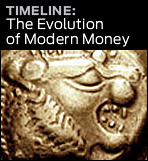
PREV ARTICLE
NEXT ARTICLE
FULL ISSUE
PREV FULL ISSUE
A BRIEF HISTORY OF MONEY
Bill Rosenblum forwarded this article from the engineering organization IEEE's Spectrum magazine titled "A Brief History of Money
Or, how we learned to stop worrying and embrace the abstraction".
-Editor
It was not an entirely original idea. Earlier rulers had sanctioned paper money, but always alongside coins, which had been around for centuries. Kublai’s daring notion was to make paper money (the chao) the dominant form of currency. And when the Italian merchant Marco Polo visited China not long after, he marveled at the spectacle of people exchanging their labor and goods for mere pieces of paper. It was as if value were being created out of thin air. Kublai Khan was ahead of his time: He recognized that what matters about money is not what it looks like, or even what it’s backed by, but whether people believe in it enough to use it. Today, that concept is the foundation of all modern monetary systems, which are built on nothing more than governments’ support of and people’s faith in them. Money is, in other words, a complete abstraction—one that we are all intimately familiar with but whose growing complexity defies our comprehension.
To read the complete article, see:
A Brief History of Money
(spectrum.ieee.org/at-work/innovation/a-brief-history-of-money/0)
The Numismatic Bibliomania Society is a non-profit organization promoting numismatic literature. See our web site at coinbooks.org. To submit items for publication in The E-Sylum, write to the Editor at this address: whomren@gmail.com To subscribe go to: https://my.binhost.com/lists/listinfo/esylum All Rights Reserved. NBS Home Page Contact the NBS webmaster 
|
